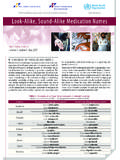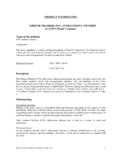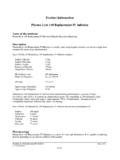Transcription of Platelet Additive Solutions (PAS) - SEABB
1 Platelet Additive Solutions (PAS) Jose Lima, MD Medical Director, Southern Region March 2012 Isotonic, saline based media Citrate: anticoagulant Acetate: fuel of aerobic Platelet metabolism North America Platelets are predominantly stored in anticoagulated plasma Short shelf life: limited buffering capacity Plasma associated risks Advantages of PAS use Patient benefit manufacturing PAS: Definition Current Status of Additive Solutions for Platelets. Hiba Alhumaidan, and Joseph Sweeney*. Journal of Clinical Apheresis 00:000 000 (2012) PAS: Advantages No published clinical of hemovigilance data to support those theoretical benefits 1995 PAS II first used in Europe PAS II acetate as a energy source for platelets citrate to prevent clumping and activation sodium chloride for osmolarity. 2007 PAS III approved in Europe (stand-alone) PAS III (InterSol ) is similar to PAS II addition of phosphate: pH buffer 2002 as part of the Intercept pathogen reduction system PAS Background PAS III used in a fixed ratio with plasma 65% PAS and 35% plasma PAS III has no pharmacologic effect in vivo Developed to: Increase Platelet viability during storage Minimize plasma loss/optimize components donated Reduce plasma-related transfusion rxs Clinical efficacy of PAS units vs.
2 Plasma has been evaluated no differences in bleeding outcomes PAS Background FDA approved 12/2009 PAS III; PAS-C; InterSol (Fenwal/Baxter, Lake Zurich, IL) Approved only to be used w/ AMICUS apheresis syst. (Fenwal/Baxter) leukocyte-reduced apheresis units PAS apheresis platelets: 65% PAS and 35% plasma Not yet available in the SE ARC system Stored up to 5 days at 20-24 oC with continuous agitation Fenwal has validated BacT/ALERT use w/ PAS Platelet units ICCBBA (manages/develops/licenses ISBT 128) has added PAS to ISBT 128 product codes PAS III Platelets derive energy from glucose oxidation through glycolysis (cytoplasm) lactic acid -oxidation of long-chain fatty acids (mitochondria) coupled with oxidative phosphorylation (very efficient) requires O2 gas permeability is critical for O2 and CO2 diffusion (gas permeable container) Storage associated pH decline (< ) Platelet viability becomes severely compromised Buffer systems: gluconate, phosphate, bicarbonate Platelet Metabolism Fig 1.
3 Metabolic pathways of PLTs with a focus on the role of acetate and the buffering of hydrogen ions derived from anaerobic glycolysis. Beside free fatty acids, acetate can serve as substrate for the oxidative metabolism in the tricarboxylic acid cycle. Furthermore, acetate can act as an alternate buffer to HCO3 and phosphate (n n na). Platelet Metabolism Transfusion Medicine Reviews, Vol 20, No 2 (April), 2006: pp 158-164 Platelet Metabolism Glucose is essential Supplied by the retained plasma Difficult to replace with PAS Caramelizes with sterilization under physiologic pH Without agitation ( manufacture and shipping) Anaerobic glycolysis increases pH decreases: buffer system needed Glucose containing PAS Allows for greater plasma volume removal 2 studies with PAS II decreased CCI for the PAS-stored platelets versus platelets in plasma Interval between Platelet transfusions, # of transfusions, and # or severity of bleeding episodes not statistically different de Wildt-Eggen J, Nauta S, Schrijver JG, et al.
4 Reactions and Platelet increments after transfusion of Platelet concentrates in plasma or an Additive solution: A prospective, randomized study. Transfusion 2000;40:398-403. Kerkhoffs JL, Eikenboom JC, Schipperus MS, et al. A multicenter randomized study of the efficacy of transfusion with platelets stored in Platelet Additive solution II versus plasma. Blood 2006;108:3210-5. 1 study with PAS III compared platelets in PAS III, platelets in plasma, and platelets in PAS-C treated with the INTERCEPT pathogen reduction technology (PR-PAS-C) CCI not statistically different between PAS III and plasma units Interval between Platelet transfusions, # of transfusions, and # or severity of bleeding episodes not statistically different Kerkhoffs JL, van Putten WL, Novotny VM, et al. Dutch-Belgian HOVON cooperative group. Clinical effectiveness of leucoreduced, pooled donor Platelet concentrates, stored in plasma or Additive solution with and without pathogen reduction.
5 Br J Haem 2010;150:209-17. Unclear if different results are due to different chemistry of PAS II and PAS III Clinical Efficacy Incidence of transfusion rxs may be reduced 3 studies w/ PAS II showed decreased incidence of allergic rxs de Wildt-Eggen J, Nauta S, Schrijver JG, et al. Reactions and Platelet increments after transfusion of Platelet concentrates in plasma or an Additive solution: A prospective, randomized study. Transfusion 2000;40:398-403. Kerkhoffs JL, Eikenboom JC, Schipperus MS, et al. A multicenter randomized study of the efficacy of transfusion with platelets stored in Platelet Additive solution II versus plasma. Blood 2006;108:3210-5. Herve F, Tardivel R, Semana G, Andreu G. Large scale use of Platelet Additive Solutions (PAS) reduces allergic type transfusion adverse events. Vox Sang 2007;93 (Suppl): 267. 1 randomized control trial with PAS III showed no difference Kerkhoffs JL, van Putten WL, Novotny VM, et al.
6 Dutch-Belgian HOVON cooperative group. Clinical effectiveness of leucoreduced, pooled donor Platelet concentrates, stored in plasma or Additive solution with and without pathogen reduction. Br J Haem 2010;150:209-17. 2 large observational hemovigilance studies w/ PAS III showed decreased incidence of transf. rxs Osselear JC, Messe N, Hervig T, Bueno J, Castro E, Espinosa A, Accorsi P, Junge K, Jacquet M, Flament J, Corash L. A prospective observational cohort safety study of 5106 Platelet transfusions with components prepared with photochemical pathogen inactivation treatment. Transfusion 2008;48:1061-71. Osselear JC, Cazaneve JP, Lambermont M, Garraud O, Hidajat M, Barbolla L, Tardival R, Defoin L, Waller C, Mendekl I, Raidot JP, Kandel G, Demeuter R, Fabigli P, DEhenau D, Arroyo JL, Padron F, Gouezec H, Corral M, Jacquet M, Sundin D, Lin L, Corash L. An active hemovigilance programme characterizing the safety profile of 7437 Platelet transfusions prepared with amotosalen photochemical treatment.
7 Vox Sang 2008;94:315-23. Transfusion Reactions Current Status of Additive Solutions for Platelets. Hiba Alhumaidan, and Joseph Sweeney*. Journal of Clinical Apheresis 00:000 000 (2012) PAS: Formulations Platelet collection procedure and storage container is the same Platelet counts and storage fluid volumes are not affected Irradiation and volume-reduction are not affected Variation in color is expected Platelets in PAS may be lighter in color Swirl can still be detected. PAS does not contain mannitol, adenine or dextrose Does not have same concerns as some RBCs Additive Solutions Review of contents should be performed w/ neonatologists address any potential concerns Discuss use PAS w/ Transfusion Committees prior to implementing its use For Transfusion Services and Blood Centers Additional PASs under development Platelets in PAS have equivalent efficacy compared to standard units Clinical outcome: bleeding PAS units appear to have lower risk for allergic transfusion rxs Reduced amount of plasma required for storage Coag factor values (in the AABB Technical Manual) will be reduced Reduced risk of hemolytic transfusion rxs due to ABO incompatibility PAS should not be directly infused into a patient PAS Summary Thank you.
8










